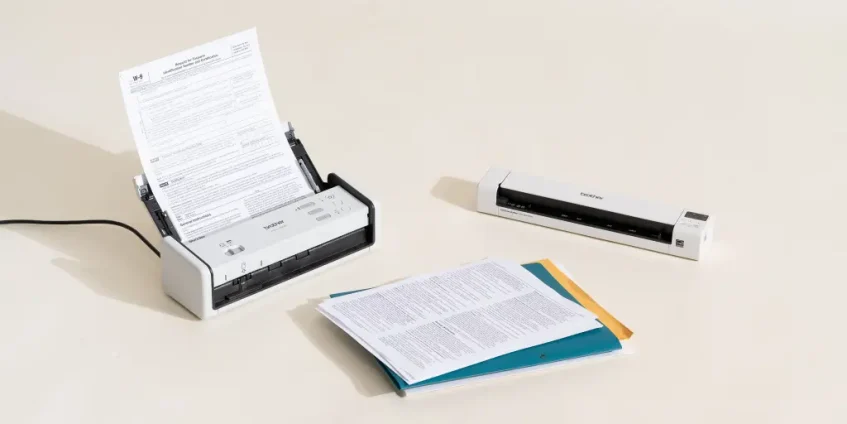
Tips on Buying a Scanner for Document Digitisation
In this era of rapid technological advancements, when the world becomes more mobile and digital, businesses are impacted in a way that’s never been before. The process of digitisation has offered many opportunities for businesses to improve the way they operate and has helped them become more efficient and provide better services for their customers.
It encompasses different processes where information is converted into a computer-readable format and is an increasingly important aspect of operating a business nowadays. No matter your business size, if you want to declutter the office, digitise archives, or optimise workflow, you can buy a scanner for document digitisation. It’s a device that enables fast and precise conversion of paper documents into digital files that can be viewed, edited and stored on a computer.
Scanners work by using a light source and a photosensitive sensor to capture the content of a document. When you place the document on the scanning bed and initiate the scan, the light source illuminates the document; the sensor captures the reflected light and converts the light patterns into digital information.
They’re indispensable in places where there is a need for intensive work with paper documentation. Scanners come in various designs, and finding the right one can be a simple task if you follow a few simple tips, such as the following.
Tips on Choosing the Right Document Scanner for Your Business
Know the Most Common Types of Scanners Available
There are various types of scanners available on the market, each designed for a specific purpose. The most common types include flatbed, sheetfed and portable scanners.
Flatbed
They’re some of the most popular options, and for a good reason. They’re simple and easy to use and are typically seen in offices as part of multifunctional printers. Their flexible scanning capabilities make them a great choice for many applications. A flatbed scanner is a versatile digitisation device and an excellent solution if you need to scan fragile or bound materials.
Consider scan resolution, as it’s a very important feature that can make a huge difference when it comes to digitising old or fragile documents. Additionally, colour quality, the size and speed of the flatbed are important features that can impact both the quality of the scans and the overall experience.
Sheetfed
They’re specifically designed for scanning loose sheets of paper and unbound documents. The paper is placed on a feeder tray, and once the scanning process begins, the pages are automatically fed through the machine and digitised one after another.
Sheetfed scanners are usually compared in terms of the paper weight and size they can handle, duty cycle rating, and scanning speed. Some models offer a duplex capability, and they can automatically copy both sides of loose paper sheets.
Portable
Portable scanners are compact and easy to carry around. This type of document scanner is ideal if you’re out of the office more often. They can be handheld, wireless, or foldable.
Think About the Documents You Are Going to Scan

To determine the right type of scanner for your business needs, consider the types of documents you’ll be scanning. If you’re planning to scan a high volume of paperwork regularly, you’ll need a more robust scanner. If you only need to scan a small number of documents occasionally, then a portable scanner might be the right choice.
Each document scanner can scan A4 paper; however, depending on the model, you can scan other formats and documents, such as A3, A5, A6, A8, B5, business cards, and more. OCR is an important feature of a scanner, as it recognises text in files, making the scanned file searchable.
Also, make sure the scanner will integrate with your current system. Before making a purchase, find out what type of technology it integrates with and if it matches your system, or you’ll need to upgrade it so your documents will be easily accessible after scanning them.
Understand the Different Connectivity Options
The ability to connect the scanner to other devices is crucial. Almost every scanner comes with a USB connection, and some have Wi-Fi connectivity, too, which is useful for wireless scanning to computers or cloud storage. Scanners with network capabilities are essential for larger offices where multiple users need access.
Consider the Space You Have Available
Document scanners vary in size, and knowing what will fit comfortably in your workspace is crucial. While some scanners are large and bulky and take up more room, others are small and compact and can help you save some valuable space in the office.
Final Thoughts
Using a scanner for document digitisation offers several advantages. First, it allows you to create digital copies of important documents, preserving them in a secure and easily accessible format. Also, you can share documents electronically, reducing the need for physical copies, and enhance scanned images, improving their quality and making them more versatile. You can use it for scanning documents such as contracts, invoices, and reports and easily manage and organise paperwork.
There are different types of scanners to choose from, each one of them suitable for specific digitisation needs, and their use and function vary with each project. Whether you’re scanning large or small quantities of documents weekly, you can find the right scanner for your business’s needs.


Sorry, the comment form is closed at this time.